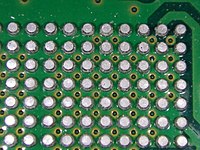
Photo from wikipedia
Abstract Introduction of ultra-low κ (ULK) material into advanced back end of line (BEOL) stacks has improved the electrical performance of the flip-chip microelectronic packages. However, the integration of the… Click to show full abstract
Abstract Introduction of ultra-low κ (ULK) material into advanced back end of line (BEOL) stacks has improved the electrical performance of the flip-chip microelectronic packages. However, the integration of the brittle and porous ULK materials presents several mechanical reliability challenges due to chip-package interaction effects. One of the primary failure modes in a organic flip-chip microelectronic package is delamination of interlayer dielectric (ILD) layers. Thermo-mechanical stresses that arise at the end of flip-chip assembly process can be high enough to cause fracture of the ILD layers in the vicinity of a solder bump. It has been observed from experiments that two bumps subjected to apparently same amount of thermo-mechanical stresses and same process history can exhibit difference in failure pattern. Current numerical models nor micro- scale interfacial fracture characterization experiments such as double cantilever beam (DCB) or four-point bend (FPB) tests are not capable of predicting such a failure. Such a behavior is possible only if the adhesion strength of the ILD layers are not constant but varies spatially from bump to bump. The difference in adhesion strength between adjacent bumps can be attributed to the difference in trace pattern layout or via distribution. In order to understand the failure at the bump level that is sensitive to capture differences in local trace patterns, microscale test techniques need to be developed. The focus of this work is to demonstrate a new reliable microscale test technique performed using nano-indenter to measure the mechanical reliability of BEOL stacks. A high-load spherical head is used to apply a known displacement on a solder bump coated with a ceramic. The force initial increases and suddenly drops indicating failure. Cross-sections of the tested bumps clearly indicate crack propagating through the BEOL stack while the coated bump remains intact. Since the forces subjected on the bump during the test is similar to the forces subjected on the bump during flip-chip assembly, the critical force can be used as a measure of fracture strength of the BEOL stack. The results from the test indicate that the critical force varies from bump to bump and the results are repeatable. Furthermore, finite-element model of the test is developed. The failure of the ILD layers is simulated using cohesive zone (CZ) elements and the mixed-mode traction-separation parameters required to characterize the CZ elements are extracted from macro-scale test techniques like DCB and FPB tests. The force-displacement (P-Δ) plot from the model mimics the experiment and predicts the average value of the critical force observed in experiment.
Journal Title: Engineering Fracture Mechanics
Year Published: 2017
Link to full text (if available)
Share on Social Media: Sign Up to like & get
recommendations!